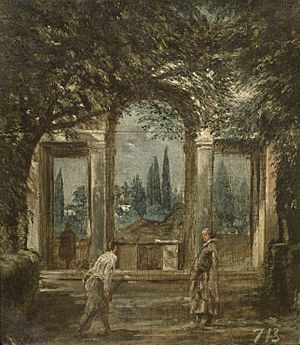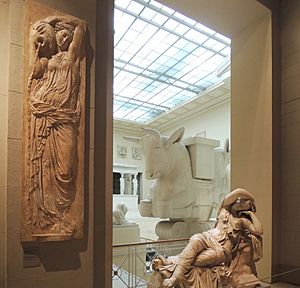Sleeping Ariadne facts for kids
The Sleeping Ariadne is a very famous ancient Roman sculpture. You can find it in the Vatican Museums in Vatican City. It's a copy of an even older Greek sculpture made around 200 BC.
The sculpture shows a woman lying down, half-sitting. Her legs are crossed, and her head rests on her left arm. Her right arm is thrown over her head. She wears a long dress called a chiton. There are other copies of this sculpture, like one at Wilton House and another called the "Medici Ariadne."
In 1512, Pope Julius II bought the sculpture. It was placed in the Belvedere Courtyard at the Vatican. It was near other famous statues like the Laocoön and the Belvedere Apollo.
At first, people thought the sculpture was Cleopatra, a famous Egyptian queen. This was because of a snake-shaped bracelet on her arm, which they thought was the asp (a type of snake) that killed Cleopatra. People even imagined she looked like she had fainted or was restless.
This "Cleopatra" sculpture became a very important model for artists. Many painters and sculptors used her pose, with one arm bent above the head, to show someone sleeping.
Scholars like T.B.L. Webster noticed her pose seemed uneasy, like she was between sleeping and waking. This was a new way to show Ariadne in art. Ariadne is a figure from Greek myths. One idea is that she might soon wake up and be angry at Theseus, who left her.

Contents
Renaissance Art and the Sculpture
During the Renaissance, artists were very inspired by this sculpture. For example, Michelangelo used the way her arms are wrapped around her head in his famous sculptures Night and Dawn.
The "Cleopatra" sculpture was placed on a Roman sarcophagus (a stone coffin). It was even turned into a fountain in a special alcove in the Vatican gardens. People thought it looked like a "Sleeping Nymph" (a nature spirit) from an old poem. This poem was actually written by a scholar named Giovanni Antonio Campani, but many believed it was truly ancient Roman.
This idea of a "Sleeping Nymph" in a beautiful garden became very popular. It helped create lovely garden spots that reminded people of classical times. In the 1530s, the alcove where the sculpture was placed was even redecorated to look like a grotto (a small cave).
Later, in the 1550s, the sculpture was moved indoors. It became the main focus of a long art gallery, still acting as a fountain in a shallow grotto. This room became known as the Stanza Cleopatra. When the Museo Pio-Clementino was created, the sculpture got a new display, still on a sarcophagus that showed a battle of the Titans.
The Sculpture Through the Centuries

Many poems were written about the sculpture in the 1500s. Some were even written as if the statue itself was speaking!
The sculpture was so admired that Primaticcio made molds of it. These molds were used to create bronze copies for Francis I at the Palace of Fontainebleau in France. The pose was slightly changed for these copies to fit the French style of beauty. Many more copies were made from these bronzes.
Artists like Nicolas Poussin made small wax copies to study. Louis XIV also ordered marble copies. A sculptor named Pierre Julien made a marble copy while studying in Rome.
The sculpture was also popular in gardens. In England, a copy was placed in Henry Hoare's garden at Stourhead. In America, Thomas Jefferson (who later became president) received a small marble copy of the "Cleopatra" in 1805. He planned to have a sculpture gallery at his home, Monticello, but it was never built. The copy is still in his hallway today.
When Napoleon was in power, his agents took the "Cleopatra" to Paris for a short time to be part of the Musée Napoléon. But after Napoleon's defeat, it was returned to Rome with other treasures.
Finding Out It Was Ariadne
Over time, people started to question if the sculpture was really Cleopatra. Johann Joachim Winckelmann, a famous art historian, noticed that the "snake" was just a bracelet. He suggested it might be a sleeping nymph or Venus.
Finally, Ennio Quirino Visconti correctly identified the sculpture as Ariadne. He found similar poses and details on ancient carved gems and sarcophagus reliefs. By 1816, even Thomas Jefferson knew his "Cleopatra" was actually Ariadne.
The Medici Sleeping Ariadne
There's another famous version of this sculpture that was also thought to be Cleopatra for a long time. It was part of the collections at the Villa Medici in Rome. This copy was moved to Florence in 1787. Some art lovers even thought it was more beautiful than the one in the Vatican! Today, you can see it at the Uffizi Gallery.


